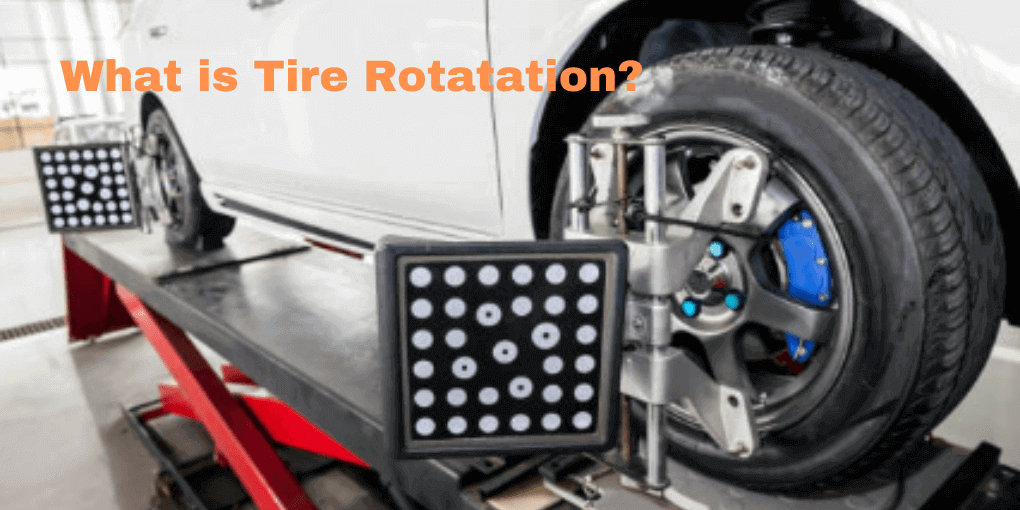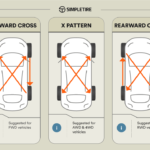Tire rotation is the process of changing the position of a vehicle’s tires. This practice ensures even tire wear and extends tire life.
Regular tire rotation is an essential aspect of vehicle maintenance, typically recommended every 5,000 to 8,000 miles or as specified by the tire manufacturer.
By rotating tires, vehicle handling and fuel efficiency can improve, potentially preventing accidents caused by uneven tread depths.
Proper tire rotation patterns depend on the type of vehicle, whether it’s front-wheel, rear-wheel, all-wheel, or four-wheel drive, as well as any specific tread patterns on the tires.
Always consult your vehicle’s owner manual or a professional service technician for the appropriate rotation pattern to ensure maximum safety and performance on the road.
Keep in mind that consistent tire rotations as part of your vehicle’s maintenance schedule can help avoid costly repairs and replacements down the line.
Tire Rotation Basics
Tire Rotation Basics – When maintaining a vehicle, tire rotation is a crucial process that ensures tires wear evenly and last longer.
This involves changing the position of each tire on a car. It is a simple, yet effective way to extend the lifespan of tires.
Let’s dive into the basics of tire rotation and understand its importance for vehicle health.
What Constitutes Tire Rotation?
Tire rotation means moving tires to different positions on your vehicle. This practice is about keeping tire wear even and balanced.
The process typically moves the front tires to the rear and the rear tires to the front.
Many times, it also involves switching the sides the tires are on.
Benefits For Your Vehicle
- Enhanced Tire Life: Rotating tires regularly leads to uniform wear, which makes tires last longer.
- Better Performance: Even tire wear helps maintain optimal handling and traction on the road.
- Improved Fuel Efficiency: Well-maintained tires reduce rolling resistance, which can improve fuel economy.
- Safer Drives: Consistent wear means your car handles predictably, making for a safer drive.
The Importance For Vehicle Longevity
The Importance for Vehicle Longevity often hinges on routine maintenance. Among these essential maintenance tasks is tire rotation, an often-overlooked service that plays a crucial role.
Ensuring tires wear evenly, tire rotation extends their lifespan and contributes to the vehicle’s overall health.
Prolonging Tire Life
Tire rotation involves changing the position of a vehicle’s tires. This process balances tread wear and is key to prolonging their service life.
Regular rotations prevent uneven tire wear, which can lead to poor performance and even early replacement. Consider these benefits of rotating tires:
- Improved tread life: Even wear helps maintain tread depth.
- Better gas mileage: Balanced tires lead to reduced friction.
- Enhanced safety: Evenly worn tires offer better grip and handling.
Impact On Overall Vehicle Health
Rotating tires affects more than just the tires themselves. It impacts the entire vehicle. Here’s how:
| Vehicle Component | Impact of Tire Rotation |
|---|---|
| Suspension | Less strain leads to longer life. |
| Brakes | Even tire wear ensures consistent braking. |
| Alignment | Regular rotation helps maintain proper wheel alignment. |
Integrating tire rotation into the vehicle maintenance schedule safeguards these components.
Uniform tire wear reduces stress on automotive parts, leading to fewer breakdowns and repairs.
It’s clear how this simple service can significantly contribute to the longevity of the entire vehicle.
Rotation Patterns And Techniques
Knowing about Rotation Patterns and Techniques is crucial.
It helps your tires wear evenly.
It lets you get the most out of them.
Different Patterns Explained
Tire rotation follows specific patterns.
These ensure even wear.
| Vehicle Type | Drivetrain | Pattern |
|---|---|---|
| Most FWD/RWD | Front/Rear Wheel Drive | X-Pattern |
| 4WD/AWD | All/Four-Wheel Drive | Front-to-Back |
| Performance | Various | Side-to-Side |
The X-Pattern swaps front and rear diagonally.
Front-to-Back moves the front straight to the back.
In Side-to-Side, tires swap sides on the same axle.
When And How To Rotate Tires
Routine tire rotation is key.
Every 5,000-8,000 miles is recommended.
- Raise the car using jacks.
- Remove the wheels carefully.
- Follow the right pattern for your car.
- Secure the wheels back onto the car.
- Check tire pressure after rotation.
Keeping a schedule helps.
Stick a reminder somewhere visible.
Stay consistent for the best results.
Signs You Need A Tire Rotation
Tire rotation is a key part of car maintenance. It helps tires wear evenly and lasts longer.
Sometimes, your car will show signs that it’s time for a tire rotation. Let’s look at how to spot those signs.
Recognizing Uneven Wear
Check your tires. Are some tires more worn than others? Uneven tread wear is a red flag.
It shows your tires are not wearing at the same rate. This causes balance issues and affects the lifespan of your tires.
- Front tires often wear faster than rear ones on front-wheel-drive vehicles.
- Rear tires may show quicker wear on rear-wheel drives.
Handling And Noise Indicators
Another sign is how your car handles. Vibration or pulling during driving means the tires are imbalanced.
Pay attention to noises too. Unusual sounds from the tires suggest it’s time for a rotation.
| Handling Issue | Possible Cause |
|---|---|
| Vibration | Uneven tire wear |
| Pulling to one side | Imbalance in tire treads |
Note: Hearing a humming or thumping from tires can mean it’s time for a rotation. This reduces the noise and balances the wear.
Diy Vs Professional Tire Services
DIY or Professional Tire Services – a question many car owners face when it’s time for tire rotation. This essential maintenance keeps your tires wearing evenly and can extend their life.
Considering a do-it-yourself approach or trusting professionals? Let’s weigh the pros and cons.
Pros And Cons Of Diy Rotation
DIY tire rotation comes with benefits and drawbacks. It’s a smart way to understand your vehicle better. Plus, it saves money.
However, you need the right tools and knowledge. If done wrong, it can cause more harm than good. Here’s a quick snapshot:
| DIY Pros | DIY Cons |
|---|---|
| Saves money | Requires tools |
| Builds car knowledge | Takes time to learn |
| Flexible timing | Potential for mistakes |
Choosing A Professional Service
Opting for a professional tire service ensures the job’s done right. Experts have the tools, and experience, and can spot other issues.
This peace of mind is valuable. Here’s what to look for when choosing a service:
- Reputation: Check reviews online.
- Experience: Look for seasoned professionals.
- Price: Compare different services.
- Convenience: Consider location and wait times.
Note: Always check if the service includes a full tire inspection. It ensures your car stays safe on the roads.
Maintaining Your Tires Post-rotation
Maintaining Your Tires Post-Rotation is vital for ensuring your vehicle’s safety and performance. Once you’ve had your tires rotated, the care doesn’t stop there.
Regular checks and maintenance can extend tire life and keep you driving smoothly.
Regular Tire Maintenance Tips
After a tire rotation, follow these steps to keep your tires in top condition:
- Check Tire Pressure: Ensure all tires have proper inflation levels. Adjust as needed.
- Inspect Tread Wear: Look for even wear across the tire surface. Uneven wear can indicate alignment issues.
- Balance Your Tires: This prevents vibrations and uneven wear. Get tires balanced at a trusted service center.
- Clean Tires Regularly: Remove dirt and debris. This prevents damage and maintains traction.
- Drive Gently: Avoid fast accelerations and hard stops. Smooth driving preserves tire condition.
Monitoring For Future Rotations
Keep an eye on your tires to determine the right time for the next rotation:
- Follow Manufacturer Guidelines: Consult your vehicle’s manual for rotation intervals.
- Record Last Rotation: Note the date and mileage after each rotation to track when the next one is due.
- Watch for Signs: If you notice vibrations or uneven tire wear, schedule a rotation.
By adhering to these regular maintenance tips and monitoring for future rotations, your tires will remain in prime condition, supporting your safety and vehicle performance on the road.
Frequently Asked Questions On What Is Tire Rotation
Why Should Tires Be Rotated?
Regular tire rotation helps ensure even tire wear. This enhances road traction, preserves balanced handling, and extends tire life.
Manufacturers typically recommend rotating tires every 5,000 to 8,000 miles.
How Does Tire Rotation Affect Performance?
Tire rotation maintains optimal handling and helps prevent uneven tire wear.
Balanced tires improve vehicle stability and fuel efficiency. They also lead to a smoother and safer ride.
Can Tire Rotation Save Money?
Yes, rotating tires prolong their life, delaying replacement costs.
It can also improve fuel economy by reducing rolling resistance, thus saving money on gas over time.
Regular rotations prevent costly uneven wear patterns.
What Is The Correct Tire Rotation Pattern?
The pattern depends on your vehicle’s drivetrain. For front-wheel drive, move the front tires to the rear and the rear to the front in a cross pattern.
For rear-wheel or four-wheel drive, it’s often the opposite. Consult your vehicle’s manual for specifics.
Conclusion
Understanding tire rotation is crucial for vehicle maintenance and safety.
Regularly rotating your tires ensures even wear, extends tire life, and improves handling.
Remember to schedule this service as recommended by your manufacturer to maintain optimal performance and safety on the road.
Keep your journey smooth and your tires in top condition with consistent tire rotations.

Sudatta is a passionate automotive enthusiast and expert in the field. With a keen eye for detail and a love for all things automotive, he shares insightful articles and reviews to ignite the automotive passion in readers.




